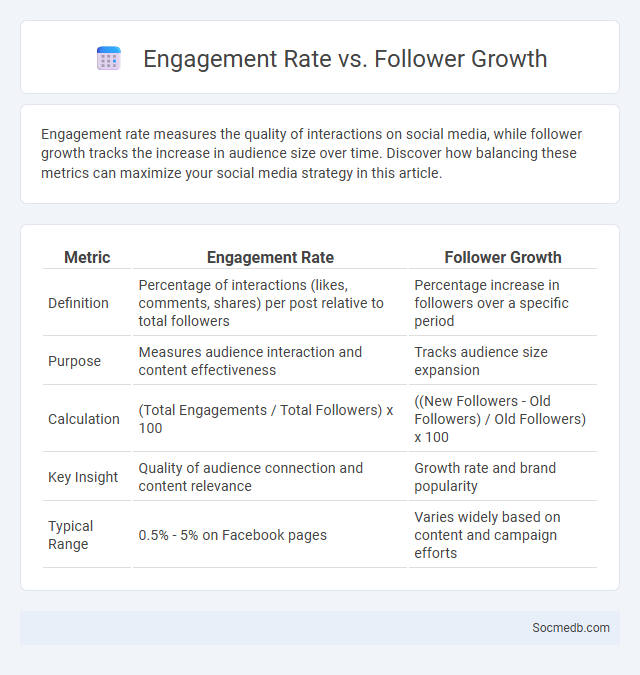
Photo illustration: Engagement Rate vs Follower Growth
Engagement rate measures the quality of interactions on social media, while follower growth tracks the increase in audience size over time. Discover how balancing these metrics can maximize your social media strategy in this article.
Table of Comparison
| Metric | Engagement Rate | Follower Growth |
|---|---|---|
| Definition | Percentage of interactions (likes, comments, shares) per post relative to total followers | Percentage increase in followers over a specific period |
| Purpose | Measures audience interaction and content effectiveness | Tracks audience size expansion |
| Calculation | (Total Engagements / Total Followers) x 100 | ((New Followers - Old Followers) / Old Followers) x 100 |
| Key Insight | Quality of audience connection and content relevance | Growth rate and brand popularity |
| Typical Range | 0.5% - 5% on Facebook pages | Varies widely based on content and campaign efforts |
Understanding Engagement Rate: Definition and Importance
Engagement rate measures the level of interaction social media content receives, including likes, comments, shares, and clicks, relative to the audience size. This metric helps marketers evaluate the effectiveness of campaigns and gauge audience interest, making it crucial for optimizing content strategies. Higher engagement rates typically indicate stronger audience connection and can improve organic reach on platforms like Instagram, Facebook, and Twitter.
What is Follower Growth and Why Does It Matter?
Follower growth on social media refers to the increasing number of users who choose to follow your profile, indicating expanding audience reach and engagement potential. Tracking follower growth helps measure the effectiveness of your content strategy, brand visibility, and influence within your niche. Your follower growth directly impacts social proof, which can boost trust, enhance your online presence, and drive higher conversion rates.
Key Differences Between Engagement Rate and Follower Growth
Engagement rate measures the interaction level--likes, comments, shares--relative to the total followers, reflecting audience involvement and content effectiveness. Follower growth tracks the increase or decrease in the number of followers over time, indicating brand reach and audience expansion. While engagement rate highlights content resonance, follower growth signals overall account popularity and potential market influence.
Measuring Engagement Rate: Tools and Metrics
Measuring engagement rate on social media requires analyzing key metrics such as likes, comments, shares, and click-through rates to evaluate audience interaction effectively. Tools like Hootsuite, Sprout Social, and Buffer provide comprehensive dashboards that aggregate engagement data, allowing marketers to identify trends and optimize content strategy. Calculating engagement rate as a percentage of total followers or impressions ensures accurate benchmarking across platforms like Instagram, Facebook, and Twitter.
Analyzing Follower Growth Patterns Over Time
Analyzing follower growth patterns over time reveals crucial insights into audience engagement and content strategy effectiveness on social media platforms. Tracking metrics such as daily follower increases, peak interaction periods, and demographic shifts helps optimize your posting schedule and tailor content to maximize reach. Understanding these patterns enables you to make data-driven decisions that accelerate community growth and enhance brand presence.
Engagement Rate vs Follower Growth: Which Metric to Prioritize?
Engagement rate measures the quality of interactions like likes, comments, and shares relative to your follower count, indicating how actively your audience connects with your content. Follower growth shows the increase in your audience size, reflecting your brand's reach and potential market expansion. You should prioritize engagement rate for building a loyal community and follower growth when aiming to broaden your brand visibility and attract new customers.
The Impact of Engagement Rate on Social Media Success
Engagement rate serves as a critical metric in measuring social media success, reflecting the interaction level between content and audience through likes, comments, shares, and clicks. Higher engagement rates enhance algorithmic visibility, increasing organic reach and boosting brand awareness across platforms like Instagram, Facebook, and Twitter. Brands leveraging data-driven strategies to optimize engagement rates often see improved customer loyalty and higher conversion rates.
Strategies to Improve Both Engagement Rate and Follower Growth
To improve both engagement rate and follower growth on social media, create targeted content that resonates with your audience's interests and encourages interaction through questions, polls, or calls to action. Use analytics tools to identify peak posting times and optimize your schedule for maximum visibility, while leveraging trending hashtags to expand reach. Focus on building authentic relationships by responding to comments and messages, demonstrating genuine interest in your community to foster loyalty and sustained growth.
Common Mistakes When Tracking Social Media Metrics
Common mistakes when tracking social media metrics include relying heavily on vanity metrics such as likes and followers, which do not necessarily correlate with business goals or engagement quality. Ignoring contextual data and failing to align metrics with specific campaign objectives leads to misinterpretation of social media performance. Overlooking the importance of tracking conversion rates and audience sentiment analysis results in missed opportunities for optimizing content strategy and improving ROI.
Choosing the Right Metrics for Your Social Media Goals
Selecting relevant social media metrics tailored to specific goals enhances the effectiveness of digital marketing campaigns. Key performance indicators such as engagement rate, reach, conversion rate, and click-through rate provide valuable insights into audience behavior and content impact. Aligning metrics with objectives like brand awareness, lead generation, or customer retention enables precise measurement and optimization of social media strategies.
 socmedb.com
socmedb.com